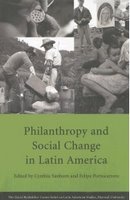The Catholic Church and Christian charity in Latin America

Since this week’s topic is religion, I thought it will be interesting to share some of the perspectives given in a book that I am reading about philanthropy in Latin America. In case if you are interested the name of the book is “philanthropy and social change in Latin America”.
I like to compare the cases/situations that we see in the U.S. with other cases from the Latin American region. At one point in our class I thought, do we (Latin Americans) really do philanthropy? The answer was some kind yes… We may not call the practices volunteerism or fundraising because we are more disorganized and perhaps forget to name the activities or practices, but philanthropy definitely exists. So, I started thinking when I was in a kid in Costa Rica about the number of times that my family and I visited the children’s hospital just to chat with ill orphans (volunteerism), the in kind donations that the community made to the retirement home in my town (donations) and the “x” number of hours that my grand father donated to the events organized by Catholic Church (volunteerism). These are just a couple of examples of philanthropic practices in my country that are strongly related with religion especially the Catholic.
I want to point out some facts that this book mentioned. In Latin America, it is not surprising that the Catholic Church has played a central role in the history of philanthropy, given that 80-95 % considered themselves of the Catholic faith. During the Colonial period, the Church was the principal provider of education, health and social welfare services. During the 20th century, social movements were inspired by the new ideals and a number of Catholic activists were founders and members of grassroots organizations, NGOs and human rights groups. At the end of the 20th century almost all doctrinal within the Church were reflected in hands-on initiatives with preferential concern for the poor.
Presently, things have changed for the Catholic Church. The Church continues to play an important role in all forms of philanthropy, even though its historical influence appears to have diminished in comparison with past eras. It is also interesting to highlight the diversity of religious faiths and organizations operating in the region today, including various strands of Judaism, Protestant, evangelical groups and even Muslim communities. Some examples of their work are: human rights movement in Peru, the campaign against the hunger in Brazil, and the mobilization of humanitarian responses to the Argentine crisis in 2000. The book also mentions an organization named Catholic Relief Services http://www.crs.org/ an organization that focus on development, human rights and social justice for low-income communities. It is the first time that I hear about this organization but I noticed that has projects in 99 countries.
It will be interesting to share the philanthropic practices from other religions in the U.S. or other countries, what do you think?

1 Comments:
At 3:51 PM, October 16, 2006, Evelyn said…
Evelyn said…
From what I know in my country, the Catholic Church gets a lot of donations from individuals. I know that people are fanatics to the Church and for example they donate properties like houses, farms, also cars and of course money. The Church also organizes pilgrimages (this is based on faith and tradition) that attract hundreds of people every year and collaborators (or volunteers as you may call them here in the U.S.) sell food and other things to Catholic followers. They get a lot of money from these special events.
I will try to find numbers ($) about the donations that the Church get. My point is that the Catholic Church in Latin America and followers do so many philanthropic activities but sometimes we don’t label those.
Post a Comment
<< Home